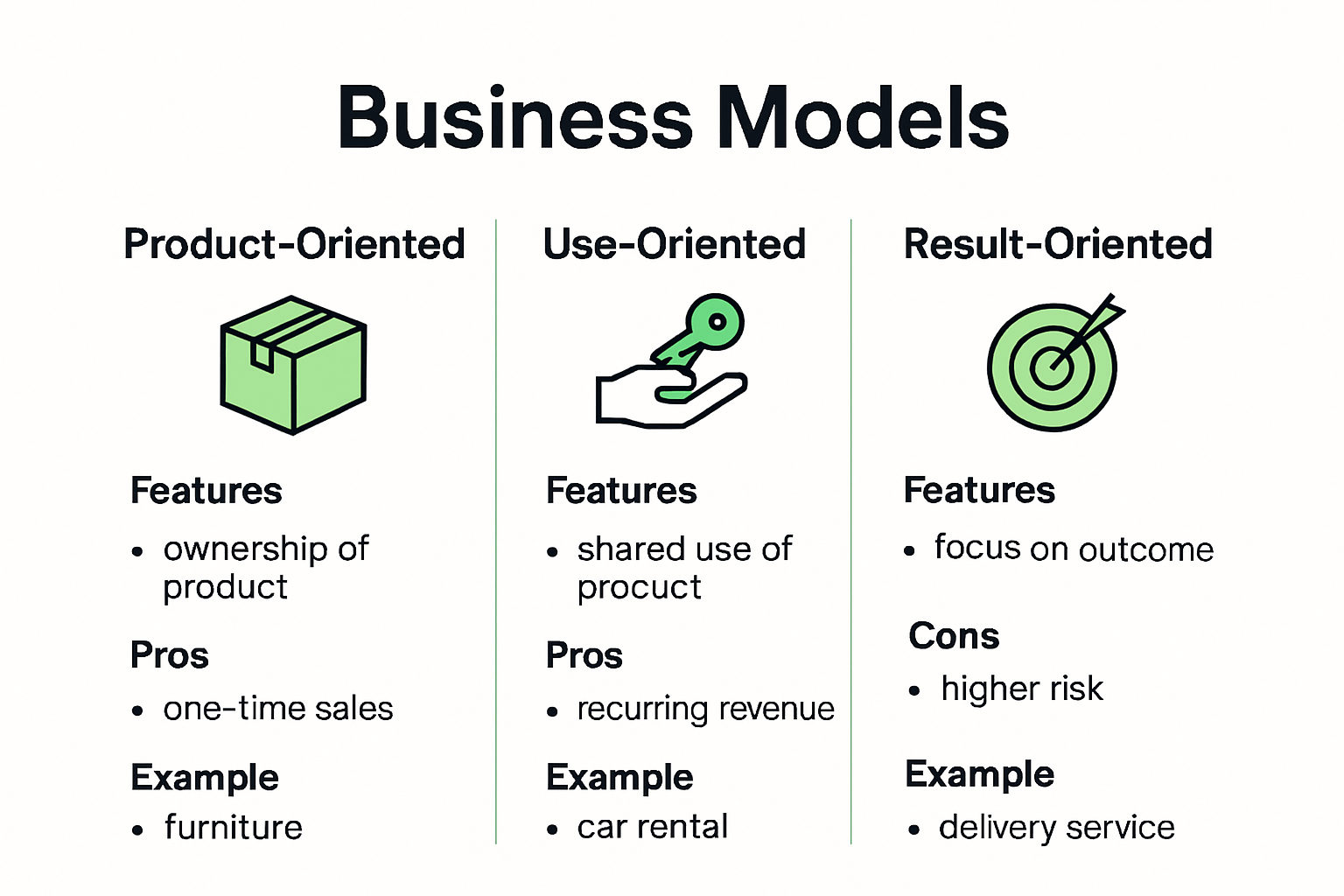
What Is a Business Model? Simple Guide for Future Entrepreneurs 2025
Every great business starts with a simple idea, but turning that idea into steady income is where most new founders get stuck. It sounds surprising, yet over 90 percent of startups never survive beyond their first few years, largely because they lack a clear business model. What most people miss is you do not need a million-dollar invention, you just need the right framework for how your business makes money and delivers value.
Table of Contents
- Understanding What Is Business Model
- The Fundamental Components Of A Business Model
- Strategic Design And Economic Logic
- Economic And Social Value Creation
- Key Types Of Business Models Explained
- Foundational Business Model Categories
- Product-Service Business Model Innovations
- Strategic Model Selection And Adaptation
- How To Choose The Right Business Model
- Assessing Your Unique Value Proposition
- Financial Viability And Resource Alignment
- Iterative Model Development And Validation
- Practical Steps To Build Your First Business Model
- Defining Your Value Proposition
- Mapping Out Key Business Components
- Financial Planning And Model Validation
Quick Summary
Understanding What Is Business Model
Business models represent the strategic blueprint that transforms entrepreneurial ideas into sustainable revenue streams. They are not just theoretical constructs but practical roadmaps that explain how organizations create, deliver, and capture value in the marketplace.
The Fundamental Components of a Business Model
At its core, a business model is a comprehensive framework that outlines how a company operates and generates profit. According to MIT Sloan Management Review, a robust business model comprises four critical elements: value proposition, resources, processes, and profit formula.
The value proposition answers the fundamental question: What unique problem are you solving for customers? This isn’t just about selling a product but creating a solution that addresses a specific market need more effectively than existing alternatives. For entrepreneurs, crafting a compelling value proposition means deeply understanding customer pain points and designing offerings that provide clear, tangible benefits.
Strategic Design and Economic Logic
A business model goes beyond simple transactions. Harvard Business Review defines it as the rationale of how an organization translates an innovative idea into economic value. It’s the strategic mechanism that explains how a firm converts creativity and effort into sustainable revenue.
Entrepreneurs must view their business model as a dynamic system, not a static document. The most successful models are adaptable, allowing for iteration and refinement based on market feedback. This means continuously evaluating your resources, understanding customer preferences, and being willing to pivot when necessary.
Economic and Social Value Creation
Modern business models are not solely about financial gain. As Wikipedia’s business model overview suggests, they can encompass economic, social, cultural, and other contextual value dimensions. This holistic approach recognizes that businesses operate within broader ecosystems, where success is measured not just by profit but by impact.
For aspiring entrepreneurs, understanding your business model means asking critical questions: How will you solve customer problems? What unique resources do you possess? What processes will you use to deliver value? How will you generate sustainable revenue? Learn more about identifying business opportunities to refine your strategic approach.
The most effective business models are those that balance innovation, practicality, and a deep understanding of market dynamics. They are living documents that evolve with your business, providing clarity, direction, and a strategic framework for turning entrepreneurial vision into tangible success.
Key Types of Business Models Explained
Entrepreneurs navigating the complex world of business strategy must understand the diverse landscape of business models. Each model represents a unique approach to creating, delivering, and capturing value in the marketplace.
Foundational Business Model Categories
According to the University of Phoenix, three primary business model archetypes emerge: the Manufacturer model, the Marketplace model, and the Subscription model. Each offers distinct advantages and challenges for aspiring entrepreneurs.
The Manufacturer model involves creating goods from raw materials and distributing them directly to consumers. This approach provides maximum control over product quality and supply chain but requires significant upfront investment in production capabilities. Manufacturers must balance production costs, product innovation, and market demand to succeed.
Below is a table summarizing the core characteristics, advantages, and challenges of the three foundational business model categories described above:
Product-Service Business Model Innovations
TU Delft’s OpenCourseWare offers a nuanced perspective on product-service business models, categorizing them into three distinct types:
- Product-oriented models: Focus on product sales with additional services like maintenance contracts
- Use-oriented models: Where the product is owned by the provider and made available to clients
- Result-oriented models: Centered on agreed outcomes rather than predetermined products
This framework demonstrates the evolving complexity of modern business strategies, where value creation extends beyond traditional transactional approaches.

Strategic Model Selection and Adaptation
Choosing the right business model is not a one-size-fits-all decision. The Open University emphasizes that business models reflect how companies generate revenues and create customer value. Entrepreneurs must critically evaluate their unique strengths, market opportunities, and customer needs.
The Marketplace model, for instance, connects retailers with customers seeking specific products, creating value through platform accessibility and convenience. Subscription models offer recurring revenue streams by providing continuous access to products or services.
Successful entrepreneurs understand that business models are not static. They require continuous refinement and adaptation. Learn about strategic business opportunity analysis to help navigate these complex strategic decisions.
Ultimately, the most effective business model aligns technological capabilities, market demand, and innovative thinking. It transforms theoretical potential into practical, sustainable value creation that resonates with target customers and stands out in competitive markets.
How to Choose the Right Business Model
Selecting the ideal business model is a critical decision that can make or break an entrepreneurial venture. It requires a strategic approach that combines market insight, personal strengths, and a deep understanding of potential customer needs.
Assessing Your Unique Value Proposition
Choosing the right business model begins with a thorough self-assessment. Entrepreneurs must critically examine their unique skills, market knowledge, and the specific problem they aim to solve. Research from Harvard Business School suggests that successful entrepreneurs align their business model with three key factors: personal capabilities, market demand, and scalability potential.
The competitive landscape plays a crucial role in this selection process. Founders need to identify gaps in the market that their skills and resources can uniquely fill. This means conducting extensive market research, understanding customer pain points, and evaluating existing solutions. It’s not just about having a good idea but about finding a model that can effectively deliver that idea to the right audience.
Financial Viability and Resource Alignment
McKinsey & Company emphasizes the importance of matching your business model to your available resources. This involves a comprehensive analysis of:
- Financial capabilities: Your current funding and potential investment sources
- Operational resources: Skills, technology, and human capital at your disposal
- Market accessibility: Your ability to reach and serve target customers
Entrepreneurs must be brutally honest about their constraints and strengths. A subscription model might seem attractive, but it requires consistent product development and customer retention strategies. A marketplace model demands robust technological infrastructure and network effects.
Below is a summary table outlining the key factors and considerations for matching business model types to available resources:
Iterative Model Development and Validation
Choosing a business model is not a one-time decision but an ongoing process of refinement. Clayton Christensen’s Innovation Principles highlight the importance of continuous validation and adaptation. Successful entrepreneurs treat their business model as a hypothesis to be tested and improved.
Learn more about analyzing business opportunities to help validate your model. This involves:
- Conducting small-scale experiments
- Gathering customer feedback
- Being willing to pivot when necessary
- Maintaining flexibility in your approach
The most resilient business models are those that can adapt to changing market conditions while maintaining a clear value proposition. This requires a combination of strategic thinking, market awareness, and the courage to make difficult decisions.
Ultimately, choosing the right business model is about creating a sustainable pathway to deliver value. It’s a delicate balance between your unique capabilities, market opportunities, and the ability to create a repeatable, scalable system that solves real problems for your target customers.
Practical Steps to Build Your First Business Model
Building your first business model is a transformative journey that requires strategic thinking, creativity, and a systematic approach. It’s about translating your entrepreneurial vision into a practical, actionable framework that can generate sustainable value.
Defining Your Value Proposition
OpenStax’s entrepreneurship guide emphasizes that the foundation of any successful business model is a clear, compelling value proposition. This means precisely articulating the unique problem you’re solving and why customers should choose your solution over alternatives.
Start by asking critical questions: What specific pain point does your product or service address? How is your solution different from existing options? Customer-centric design means going beyond surface-level features and understanding the deeper emotional and functional needs of your target market.
Mapping Out Key Business Components
Oklahoma State University’s Extension Service recommends a comprehensive approach to developing your business model by identifying and aligning key components:
- Customer Segments: Precisely define who will benefit most from your offering
- Key Activities: Outline the core actions required to deliver your value proposition
- Resources: Catalog the assets and capabilities necessary for execution
- Revenue Streams: Determine how you will monetize your solution
This systematic breakdown helps transform abstract ideas into concrete strategic plans. Each component must be carefully considered and interconnected, creating a holistic view of your business ecosystem.
Financial Planning and Model Validation
edX’s business planning resources highlight the critical importance of financial projections and operational planning. Entrepreneurs must develop realistic financial models that demonstrate potential profitability and sustainability.
Validation is key. Learn more about creating a solid business plan to refine your approach. This involves:
- Conducting market research
- Creating financial projections
- Testing assumptions through small-scale experiments
- Gathering feedback from potential customers
- Being prepared to iterate and pivot
Successful business models are not static documents but living strategies that evolve with market dynamics. They require continuous learning, adaptation, and a willingness to challenge your initial assumptions.
Building your first business model is part art, part science. It demands creativity to envision possibilities, analytical thinking to design robust strategies, and entrepreneurial courage to turn conceptual frameworks into real-world value creation. Remember, every successful business started with a simple model that was carefully crafted, tested, and refined over time.

Frequently Asked Questions
What is a business model?
A business model is a strategic blueprint that outlines how a company creates, delivers, and captures value in the marketplace. It includes components like value propositions, resources, processes, and profit formulas.
Why do most startups fail due to business model issues?
Over 90 percent of startups do not survive beyond their first few years primarily because they lack a clear and viable business model or fail to adapt it based on market feedback.
How can I choose the right business model for my startup?
To choose the right business model, assess your unique value proposition, evaluate financial viability and resources, and be open to iterative model development based on market insights and customer feedback.
What are some common types of business models?
Common types of business models include the Manufacturer model, Marketplace model, and Subscription model. Each type has its distinct advantages and challenges depending on the business needs.
Take Your Business Model From Idea to Action With siift
Building a business model that actually works is a tough challenge for aspiring founders. As the article explains, most startups struggle to move from a promising idea to a sustainable strategy. You may wonder if your value proposition is unique enough, if your financial projections are realistic, or if you are picking the right framework for growth. These decisions can feel overwhelming and slow you down before you even launch.
That is where siift comes in. You can instantly tap into an intuitive AI guide that helps you map out your business model step-by-step with tailored insights, feedback, and clear next actions. No more second guessing or spinning your wheels. If you want to analyze your opportunity deeply before committing, check out our detailed advice on business opportunity analysis for first-time founders. Ready to design a validated business plan and de-risk your founder journey? Head to siift right now and see how fast you can turn your ideas into a real path to success.
Recommended
- blog | siift | Business Plan Essentials 2025: A Beginner’s Guide for New Founders
- blog | siift | How to Set Business Goals in 2025: A Guide for New Entrepreneurs
- blog | siift | Top Reasons Businesses Fail in 2025: A Guide for New Founders
- blog | siift | How to Find Business Ideas in 2025: Proven Steps for Students and New Grads
- Consultant Business Models for IT Pros in Canada and USA 2025
- Licensing vs Franchising: Choosing the Best Growth Model for 2025 - Loft Legal

see where you stand





.svg)
.svg.png)



.svg)

